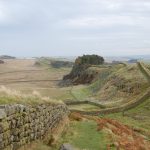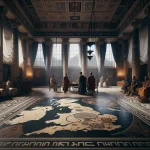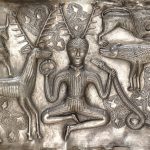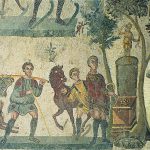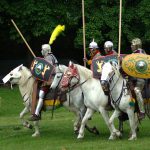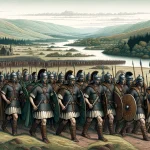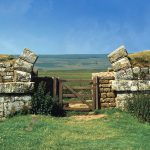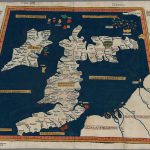Glenlochar Roman Fort
Antonine Auxiliary Fort (AD 138–161) and Flavian Auxiliary Fort (AD 69–96)
Although it is certainly set in a picturesque spot, nothing visible remains of this fort and surrounding complex of camps except the fort platform itself, lying close to the east bank of the River Dee at the southern end of Loch Ken. The fort was built in 81 AD by the Governor Gnaeus Julius Agricola and enclosed an area roughly 7 acres (2.8 ha).
The fourth summer [81AD] was spent in securing the ground hastily traversed … the Clyde and the Forth … was fortified during this summer with Roman garrisons, and the whole sweep of country to the south secured …” (Tacitus Agricola XXIII.)
There were three periods of occupation in the first century AD with the 3 forts superimposed on one another with a large annex on the north east side. The earliest one was Flavian but it was destroyed by fire; the second was Antonine, and the third was also Antonine, being a later modification of the second. There may have been an even earlier fort on a slightly different area of the site, as rubbish pits were found under the fort when it was excavated. Traces of some of the ditches could be made out surrounding the fort, and another which may have been associated with the earliest fort. It was probably built to hold foot soldiers and six marching camps have also been found on the site.
Glenlochar Roman Fort and its surrounding Temporary Camps were first identified in 1949 by Dr Kenneth St. Joseph through the presence of cropmarks. St Joseph was an early pioneer of aerial photographic techniques, assisting in identifying countless sites across the British Isles. It was known at the time of discovery of the fort that there were a series of Roman sites lying along an east-west road running along the Solway coast. To the east on the Nith there are sites at Carzield from the Antonine period and at Dalswinton from the Flavian period. Further west there was a smaller fort at Gatehouse of Fleet, which was also discovered by St Joseph using aerial photography. The location of these forts along this westward road, coupled with the Roman road from Glenlochar, towards Ayrshire suggests the development of the Roman system of cordon control.
Originally misinterpreted as the remains of an Abbey, and the area is known as Abbey Yard with Ordnance Survey maps prior to the 1940s stating that it is the site of an abbey.
The Excavations at Glenlochar Fort
The excavation at Glenlochar took place across March and April 1952. The excavation consisted of one main trench and two minor trenches. The trenches were laid out to assess the nature of the defences and to assess the layout of structures within the interior of the fort. The excavated trenches revealed that there had been a series of three superimposed forts, which for the most part retained common alignments. The first had been constructed in the Flavian period and may have been destroyed by fire. The second was constructed in the Antonine period, while the third represented later improvements also during the Antonine period. To the north of this known fort, there is the suggestion there was an earlier Flavian (Agricolan) fort on a different site: a large ditch, visible on the aerial photographs at the northern end beyond the limits of the Antonine phases. This suggests that an earlier site may be situated just north of the B795 on the higher ground.
Five Roman camps are also known at Glenlochar – showing the temporary encampment of military units – suggesting the importance of this location on the eastern bank of the Dee throughout the Roman campaigns in Scotland.
Etymology Loucovium? – The Shining Place
Etymologically speaking, Glenlochar may be connected to the ancient name Loukopibía, and derived from the Brittonic -luch-, “marshy/brackish water” (Welsh llwch, Gaelic loch),[1] or lǖch, “bright, shining”,with the adjectival suffix -ar. The first part of the name is either Brittonic glïnn- (Welsh glyn) or Gaelic gleann, both meaning “a valley”, anglicised as Scots glen.
Map References for Glenlochar Fort
Dimensions: 650 x 475 ft (c.198 x 145 m)
Area: c.7 acres (c.2.87 ha)
References for Glenlochar Fort
Air Reconnaissance of North Britain by J.K. St. Joseph in J.R.S. xli (1951) pp.60-1;
Air Reconnaissance in Britain, 1961-64 by J.K. St. Joseph in J.R.S. lv (1965) pp.79/80.
https://canmore.org.uk/site/64696/glenlochar
Roman Roads near Glenlochar Fort
Probable Military Road: SW (11) to Gatehovse Of Fleet (Dumfries & Galloway) Probable Military Road: NE (20) to Dalswinton (Dumfries & Galloway)
Sites near Glenlochar Roman Fort
- Glenlochar 2 Temporary Camp (0 km)
Marching or Temporary Camp - Glenlochar 1 Temporary Camp (0 km)
Marching or Temporary Camp - Glenlochar 5 Temporary Camp (0 km)
Marching or Temporary Camp - Dalbeattie Marching Camp (10 km)
Possible Roman Camp - Gatehouse of Fleet Fortlet (16 km)
Fortlet - Shawhead Temporary Camps (18 km)
Marching or Temporary Camp - Saint John's Town Of Dalry (20 km)
Possible Roman Settlement - Fourmerkland Camps (24 km)
Marching or Temporary Camp - Kirkland Roman Fortlet (26 km)
Fortlet - Lantonside Roman Fortlet and Annexe (27 km)
Fortlet
